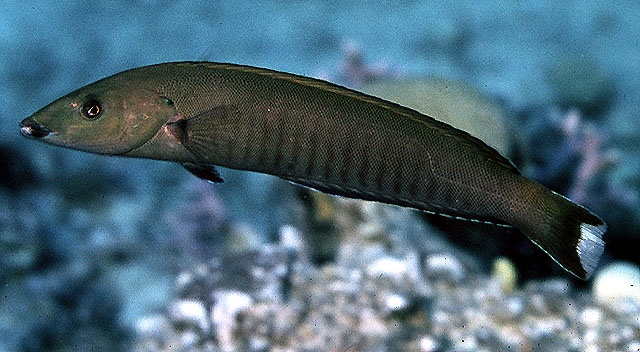Hologymnosus annulatus (Lacepède, 1801)
Ring wrasse |
|
Bankilan,
Ringwrasse,
Balaki,
Banog,
Buhuhen,
Bungat,
Danlugan,
Isdang bato,
Labayan,
Lampalampa,
Lubay-lubay,
Maming,
Maringyan,
Molmol,
Pilo-pilo,
Pirat-pirat,
Tamago,
Tausay,
Verde verde
|
| Labridae (Wrasses), subfamily: Corinae |
| 40 cm TL (male/unsexed) |
|
reef-associated; marine; depth range 8 - 40 m |
| Indo-Pacific: Red Sea and South Africa (Ref. 11228) to the Society and Pitcairn islands, north to southern Japan, south to southeastern Australia and Rapa Island. |
|
Dorsal spines (total): 9-9; Dorsal soft rays (total): 12-12; Anal spines: 3-3; Anal soft rays: 12-12. Two-color forms: the 'true' species in the Indian Ocean and Red Sea and its sibling in the Pacific regions. Females look almost black; males mainly greenish with blue face, of which Indian form shows a white band central to the body, whilst the Pacific form a pale peduncular area when in nuptial mode (Ref. 48636). Juvenile H. annulatus very closely resemble juvenile Malacanthus latovittatus (Ref.1602). Poorly developed pharyngeal teeth (Ref. 1602). |
| Found on coral reefs and rocky substrates to depths of at least 30 m (Ref. 9823) on offshore reef slopes (Ref. 90102). Juveniles generally solitary (Ref. 9710). Feeds primarily on small fishes, also on crustaceans (Ref. 2334). |
|
Least Concern (LC); Date assessed: 02 March 2009 Ref. (130435)
|
| harmless |
|
Known from Sibuyan, Romblon (Ref. 58652) and Bongo Island and Paril-Sangay Protected Seascape, Moro Gulf (Ref. 106380). Also Ref. 1602, 9823, 53416, 121724. |
Source and more info: www.fishbase.org. For personal, classroom, and other internal use only. Not for publication.

